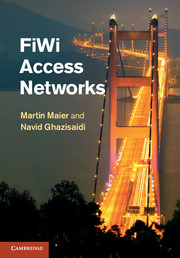Preface
Published online by Cambridge University Press: 05 January 2012
Summary
Fiber-wireless (FiWi) access networks may be viewed as the endgame of broadband access. FiWi access networks aim at leveraging on the respective strengths of emerging next-generation optical fiber and wireless access technologies and smartly merging them into future-proof broadband solutions. Currently, many research efforts in industry, academia, and various standardization bodies focus on the design and development of next-generation broadband access networks, ranging from short-term evolutionary next-generation passive optical networks with coexistence requirements with installed fiber infrastructures, so-called NG-PON1, to mid-term revolutionary disruptive optical access network architectures without any coexistence requirements, also known as NG-PON2, all the way to 4G mobile WiMAX and cellular long term evolution (LTE) radio access networks. To deliver peak data rates of up to 200 Mb/s per user and realize what some people refer to as the vision of complete fixed-mobile convergence (Ali et al. [2010]) it is crucial to replace today's legacy circuit-switched wireline and microwave backhaul technologies with integrated FiWi broadband access networks. To unleash the full potential of FiWi access networks, emerging optical and wireless access network technologies have to be truly integrated at the physical, data link, network, and/or service layers instead of simply mixing and matching them.
- Type
- Chapter
- Information
- FiWi Access Networks , pp. xix - xxPublisher: Cambridge University PressPrint publication year: 2011



